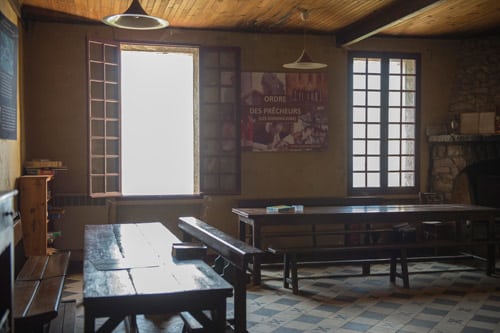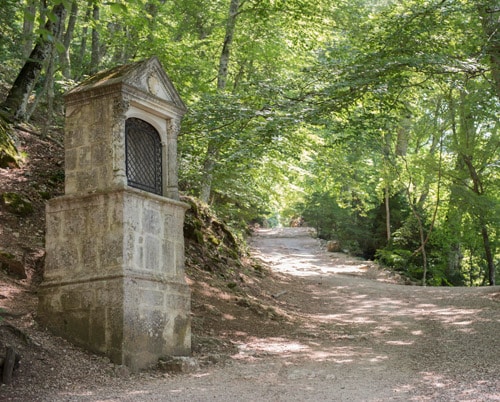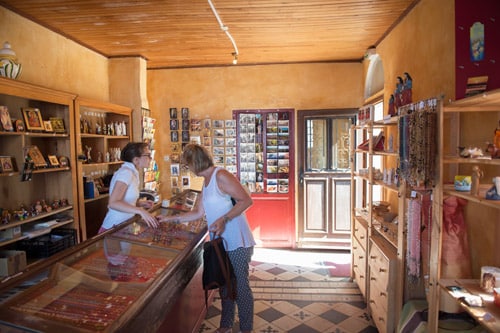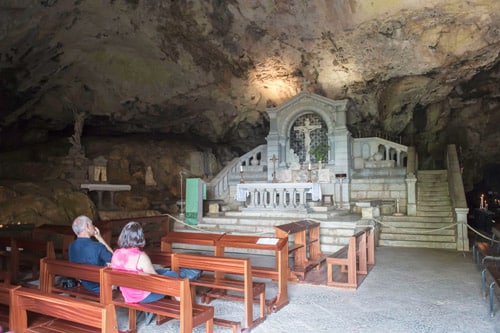The history of Grotto
Historical chronology
415-1079 : Presence of Cassianist friars on the massif.
1070-1295 : The awakening and religion development which takes place at the beginning of the 11th century lead to the installation in these places of blessing of the Saint Victor Abbey (Marseilles).
1254 : Saint Louis visits the Grotto.
1295-1481 : The successors of Charles II in the kingdom of Provence watch with great care over the Sainte Baume : confirmation of privileges accorded to religious people, mediation with the Holy See in order to promote the pilgrimage, construction of site of an hostelry to welcome the pilgrims …
1481-1789 : The Kings of France replace the Counts of Provence and give great concern to the future of the Sainte-Baume : numerous visits, development and improvement works, special protection in times of trouble and danger.
1789-1793 : Pillage of the place during the Revolution. Departure of the Dominicans.
1824-1834 : Trappist fathers and Capuchin fathers provide religious presence from a converted farmhouse on the plateau.
1859 : Return of the Dominicans at the behest of H.D. Lacordaire.
1941 : “(…) during the war, friar Gabriel Piprot d’Alleaume creates a hotel school to serve as refuge for victims of the persecutions let by the Nazis: jewish persecutions, german persecutions, polish catholic persecutions”.
Religious chronology
47 : According to the Tradition, Holy Mary Magdalene arrived at the Sainte-Baume.
Around 415 : Saint Jean Cassien creates his first priory after coming back from Egypt. Since the Vth century, monks of the Saint Victor Abbey of Marseilles are present.
1279 : Charles II of Anjou, King-to-be of Sicilia and Count of Provence, conducts excavations which lead to the discovery in Saint-Maximin of the relics of Mary Magdalene.
1295 (June 21st): With the support of Pope Bonifacius VIII, Charles II invites the Dominicans in Saint-Maximin and in La Sainte-Baume.
1629 : Pope Urban VIII creates the fraternity Mary Magdelene.
1791 : The marquis of Albertas redeems the goods of Dominicans which were sold as national property.
1859 : H.D. Lacordaire redeems the convent of Saint-Maximin, and reinstalls the Preaching Friars: he builds the Hostellerie in the plain of la Sainte Baume.
1900 : Visit of Charles de Foucauld. He will came back in 1901 and 1913.
1914 : Restoration by M.E. Vayssière of the stairs leading to the Grotto (150 steps in memory of the 150 Ave of the Rosary) and inauguration of the Calvary.
2002 : Reopening of the Grotto, closed in 1997 for renovations. Four Dominicans settle there.
2008 : The Hostellery is taken in charge by Dominicans.
From Vth to XIIIth century
From Jean Cassien to Saint Louis
It is from the Vth century that la Sainte-Baume is inhabited and Christians are attending. “Jean Cassien, the patriarch of monks of the West followed the footsteps of Mary Magdelena by seeking amoung the heights a refuge for contemplative life.”
PH. I Vincent – Extract from the book Marie-Madeleine et la Sainte-Baume
After founding the abbey of Saint-Victor, Cassien established there a priory and comes there for retreats.
“La Sainte Baume must have naturally touched his heart, so he came with some of his own and placed this guard which during a thousand years, from the IVth to the XIIIth century, stood faithful to the memory and relics of Mary Magdalena that the Provence had entrusted her. “
H.D Lacordaire – extract from the book Sainte Marie-Madeleine

A pilgrimage soon established there. Pilgrims came to the Sainte Baume the same way as in Saint-Maximin to venerate the places where Holy Mary Magdalena lived. Authentic writings attest this.
In 1117, came an italien gentleman, whom we owe the construction of a Chartreuse in Montrieux.
In 1248, pilgrimage of the Franciscan Fra Salimbene, who left a detailed account of his coming.
In 1245, the King of France, Saint Louis, came to the Sainte Baume while coming back from his first crusade in the Holy Land.

Charles II brings a particular impulse to the pilgrimage in the Sainte-Baume
We witness a revival of the Church and Christendom. It is the crusades era. The pilgrimage takes a new expansion.
In 1279, Charles II, count of Provence, King of Naples, of Sicilia and of Jerusalem, nephew of Saint Louis, rediscovers in the crypt of the Church of Saint-Maximin, the body of Mary Magdalena, which during Saracen invasions had been removed from its sarcophagi.
He contributes in a decisive manner to the pilgrimage expansion.
Writings found in the sarcophagi by Charles II:
“The year of Nativity of the Lord 7-10, the sixth day of the month of December, under the reign of Eudes, very pious King of the French, in times of ravages of the perfidious Saracen nation, the body of the very dear and venerable Mary Magdalena has been secretly and during the night transferred from her alabaster sepulcher into the marble one, and from which the body of Sidoine has been removed, so that it be more hidden and safe from the aforesaid perfidious nation.”
H.D Lacordaire, Sainte Marie-Madeleine, 1859
Second inscription found during the translation of the relics
“Here is the body of Holy Mary Magdalena graved in a wooden tablet enveloped by a wax globe”.
HD Lacordaire, Sainte Marie Madeleine, 1859
The event took place in this venerable crypt « really contemporary of the primitive Christianism in Provence ».
Revoil, Lettre à Mr Bellet
It is this one that we can, even if it has been reworked, still visit today.
Charles II obtains from Pope Bonifacius VIII, the authority to establish the Preaching Friars in place of the Benedictines, “as guardians of the relics of Holy Mary Magdalena and preachers of her virtues” and considers them “better suited to the new expansion of the pilgrimage”.
Parallel to the works conducted in Saint-Maximin – building of the basilica and the convent – measures are taken to the diligence of first Dominican priors, especially Jean Vigorsi and Jean Gobi to rearrange and enlage the priory of the Sainte-Baume.
From XIVth to XVIth century

1516: Louis of Savoy accompanied by his son François Ier
The century begins with the brilliant reign of François Ier. After Marignan, the young prince comes to pay tribute of his victory to Mary Magdalena.
“The King arrived in Saint-Maximin the 20th of January with a brilliant escort. He found in this city the Queen Claude, his wife, Queen Louise of Savoy, his mother and his sister Marguerite, wife of Duke of Alençon and since then Queen of Navarre, as well as part of their court.
The next day, the King and his court went on the pilgrimage passing by Nans. »
Escudier 1925, La Sainte Baume
“The King was very moved by the disrepair in which he found the places, and gave funds to (repair the church of the Sainte Baume where Magdalena did penance, as well as the lodging and place settings of the friars, which were obsolete and demolished” (patent letters).)
Sicard 1878 extract from Sainte Marie Madeleine et la France
Growing importance of the pilgrimage at the Sainte Baume
XIV-XVth century
Under the influence of the first Dominicans and the support of the Counts of Provence, the worship of Mary Magdalene shines more and more. The pilgrimages to Saint-Maximin and to the Sainte Baume become, after those of Rome and the Way of Saint James, the most popular pilgrimage in the Catholic West.
Dominican friars Elie and Dalmace Moner establish as eremites in the Grottos not far from the one of Mary Magdalene.
All Counts of Provence after Charles II had a particular interest in the Sainte Baume and came there in pilgrimage.
The greatest of them, the Roy René, came to engage in private prayer several times. He build a hostelry near the Grotto for pilgrims after the great fire which burned everything down in 1440. Popes also came to venerate Saint Mary Magdalene.
XVIth century and the Renaissance era
Kings of France stayed strongly attached to the Sainte Baume. After 1481, when Provence has been bond to France, they confirmed the privileges to the Dominicans, and renewed all measures taken by the Counts of Provence to keep the forest intact.
The path which lead to the Grotto soon became baptized under its current name “Path of the Kings”, as the Kings have taken the habit of coming devote themselves at the Sainte-Baume.
During the second part of the XVIth century
Numerous disorders, religious wars, plague epidemics, but the number of pilgrims remains the same.
Between 1580 and 1583, the civil authorities of Auriot take vow to pilgrimage to the Sainte Baume every Whit Monday.
From XVIIth to XVIIIth century
1660 Louis XIV in Saint-Maximin and in the Sainte-Baume
“The last King of France who came pilgrimaging the Holy Places of Provence was Louis XIV. He arrived in Saint-Maximin on February 4th 1660 with his mother, Anne of Austria, and came the next day up to the Sainte-Baume and the Saint-Pilon. On his way back, he presided to the translation of the body of Mary Magdalene in a porphyry urn which had been sent to Rome by the Master of the Order of Preachers and which was placed on the master-altar, after that the shrine inside had been opened, closed and sealed in presence of the King”.
H.D Lacordaire, extract from the book Sainte Marie Madeleine

“Therefore, at the time when the monarchy reached its highest point of splendor and wrote one century of France one of the greatest centuries of the world, she came, in the person of the King who had the priviledge to give his own name to this memorable era, bow before the remains of the humble penitent of Bethania and leave there a beam of this majesty which is still called and will always be the century of Louis XIV.”
H.D Lacordaire, extract from the book Sainte Marie Madeleine
“For the service of the pilgrimage, the preachers from Saint-Maximin wrote since 1640, manuals for pilgrims, which are at the same time lives of Holy Magdalena and prayer forms”.
H.D Lacordaire, extract from the book Sainte Marie Madeleine

Peak and decline of the pilgrimage
The beginning of the centuries set a record for affluence of pilgrims and personalities more famous. The pilgrim movement does not stop growing.
All leave accounts of their generosity and the Sainte-Baume will live one of her most glorious time.
“Never would Mary Magdalena be more popular. Never would she be more represented by artists. Pictures of the Penitent in the Sainte-Baume are abunding.”
Dolende, extract form the book Marie-Madeleine dans la Mystique des arts et des lettres
One has never seen so many pilgrims coming from all origins; saints, François de Salles, Vincent de Paul, Jeanne de Chantal ; Kings, Louis XIII (1622); Christine de Suède (1658), Louis XIV the most famous (1660).
The duchess of the Tour d’Auvergne will have restored and decorated the Chapel of Saint-Pilon, erected in 1630 by Esprit Blanc, General Controller of Provence.
But…
“the weakening of piety in France under the reign of Louis XV diminishes the devotion for Mary Magdalena. Indeed, she becomes rare among the greats, even though this was not the case among the people”.
Abbé Fallon – extract from the book Monuments inédits sur l’apostolat de Marie-Madeleine de Provence
The Revolution roars, the Sainte-Baume is desecrated
179 The National Assembly orders the closeout of religious houses. The Grotto is entirely pillaged.
1793 In order to beat the counter-revolutionary movement in the South of France, Barras and Fréron decide the total destruction of the Sainte-Baume. It is no more a pile of ruin. The Grotto is rechristened and given the name “Thermopyles”.
From XIXth century until today
1860 – After the Restoration of the Dominicans by H.D Lacordaire
This pilgrimage is during the day after a splendid feast organized in Saint-Maximin for the relocation of the relics of Mary Magdalene in a new shrine offered by the inhabitants to replace that which had been destroyed during the Revolution (present shrine in the basilica) .
“The ceremony (…) takes place on May 20, 1860.
People are crowded, coming from every corner of France.
The Archbishop of Aix presides, surrounded by the bishops of Frejus, Marseilles, Nice, Nimes, Gap …
The festival takes place in the spotlight: the newspapers of Paris sent their writers and drawers.”
B. Mountains, excerpt from The Legend of Mary Magdalene.

Frédéric Mistral was present on the pilgrimage with his “félibres”:
« It was so beautiful ! »
excerpt from a letter by Fernand Cortez

Resurrection of the pilgrimage
After the revolutionary disturbances during which the buildings of the Sainte-Baume were ransacked, life gradually is returning to normal with the help of parish priests and the resettlement of the Dominicans.
The chapel of Saint-Pilon is restored, the Grotto cleared, the roads rehabilitated.
Subscriptions are opened on the initiative of the administrative authorities to rebuild the destroyed buildings.
By order of February 1821, Louis XVII erected the Grotto as a vicarial chapel.
In 1858, Mgr. Jordany, Bishop of Fréjus-Toulon asks HD Lacordaire who had restored the Dominican order in France to bring life back to the convents of Saint Maximin and Sainte-Baume, which will be done the following year.
The Hotel is built on the plateau from a farm once owned by the Dominicans and received from the Marquis d’Albertas a few years ago: a community of brothers is assigned to there.
Then we are witnessing a real renewal of the pilgrimage.
Father Vayssière, guardian of the Grotto from 1900 to 1932, is largely associated with it. He built Nazareth and various developments for the Grotto. He had the privilege of receiving, on three occasions, the most fervent of the pilgrims in this period: Charles de Foucauld.
Nowadays, a new rise is given to the pilgrimage. The Dominicans have totally reinvested the place since July 2008 breathing life back to this long page of history written for centuries under the gaze of Mary Magdalene.





Contact
Sanctuaire de la Sainte-Baume
2200, CD 80 Route de Nans
83640 Plan-d'Aups-Sainte-Baume
France
© Sanctuary of Sainte-Baume
